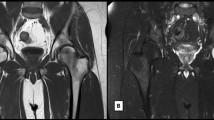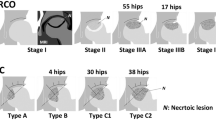Abstract
Bone marrow oedema syndrome (BMOS) of the hip includes severe hip joint pain, focal loss of radiodensity in radiographs, increased uptake in bone scintigrams and the pattern of bone marrow oedema in the femoral heads in MRI scans. In 15 patients (16 hip joints) we found the clinical and radiological signs of BMOS. On T1-weighted MRI images areas of low signal intensity could be observed in the head, neck and the intertrochanteric region of the femur in various extensions. These areas showed a significant increase in signal intensity on the T2-weighted images. Because pain was resistant to conservative therapy all these patients were treated by core decompression of the femoral head in a prospective study. Bone cores were evaluated histologically using undecalcified sections and quantitative microradiography. The existence of intramedullary oedema in exactly the regions exhibiting the MRI pattern of bone marrow oedema was verified histologically; however, bone and marrow changes similar to those of early avascular necrosis (AVN) were also visible. These findings support our assumption that BMOS might be a transitory initial phase of AVN. Therefore core decompression treatment for patients suffering pain from BMOS is recommended after excluding other diseases.
Similar content being viewed by others
References
Bloem J (1988) Transient osteoporosis of the hip: MR imaging. Radiology 167: 753–755
Higer H, Grimm J, Pedrosa P, Apel R, Bandilla K (1989) Transitorische Osteoporose oder Femurkopfnekrose? Frühdiagnose mit der MRT. Fortschr Röntgenstr 150: 407–412
Wilson A, Murphy W, Hardy D, Totty W (1988) Transient osteoporosis: transient bone marrow edema? Radiology 167: 757–760
Turner D, Templeton A, Selzer P, Rosenberg A, Petasnick J (1989) Femoral capital osteonecrosis: MR finding of diffuse marrow abnormalities without focal lesions. Radiology 171: 135–140
Vogler JB, Murphy WA (1988) Bone marrow imaging. Radiology 168: 679–693
Mitchell D, Steinberg M, Dalinka M, Rao V, Fallon M, Kressel H (1989) Magnetic resonance of the ischemic hip: alterations within the osteonecrotic, viable, and reactive zones. Clin Orthop 244: 60–77
Ficat R (1985) Idiopathic bone necrosis of the femoral head: early diagnosis and treatment. J Bone Joint Surg [Br] 67: 3–9
Plenk H, Jr (1986) The microscopic evaluation of hard tissue implants. In: Techniques of biocompatibility testing, vol 1. Williams DF (ed) CRC Press, Boca Raton, Fl., pp 35–81
Hungerford D (1979) Bone marrow pressure, venography, and core decompression in ischemic necrosis of the femoral head. In: The hip: proceedings of the seventh open scientific meeting of the Hip Society. Mosby St. Louis, Mo., pp 218–237
Shuman WP, Castagno AA, Baron RL, Richardson ML (1988) MR imaging of avascular necrosis of the femoral head: value of small-field-of-view sagittal surface-coil images. AJR 150: 1073–1078
Mitchell D (1989) Using MR imaging to probe the pathophysiology of osteonecrosis. Radiology 171: 25–26
Bassett L, Mirra J, Cracchiolo A, Gold R (1986) Ischemic necrosis of the femoral head: correlation of magnetic resonance imaging and histologic sections. Clin Orthop 223: 181–187
Mitchell D, Joseph P, Fallon M, Hickey W, Kressel H, Rao V, Steinberg M, Dalinka M (1987) Chemical-shift MR imaging of the femoral head: an in vitro study of normal hips and hips with avascular necrosis. AJR 148: 1159–1164
Lang P, Jergesen H, Moseley M, Block J, Chafetz N, Genant H (1988) Avascular necrosis of the femoral head: high-field-stregth MR imaging with histologic correlation. Radiology 169: 517–524
Hunder G, Kelly P (1986) Roentgenologic transient osteoporosis of the hip: a clinical syndrome? Ann Intern Med 68: 539–552
Dihlmann W, Delling G (1985) Ist die transitorische Hüftosteoporose eine transitorische Osteonekrose? Z Rheumatol 44: 82–86
Brody A, Strong M, Babikian G, Sweet J, Seidel F, Kuhn J (1991) MR imaging and histologic findings in a canine model. Am J Radiol 157: 351–345
Rutishauser E, Rohner A, Held D (1960) Experimentelle Untersuchungen über die Wirkung der Ischämie auf den Knochen und das Mark. Virchows Arch [A] 333: 101–118
Hofmann S, Engel A, Neuhold A, Leder K, Kramer J, Kutschera HP, Plenk H, Jr (1991) MRT-kontrollierter Verlauf von Knochenmarksödemen des Hüftkopfes nach Entlastungsbohrung. In: Stuhler T (ed) Hüftkopfnekrose. Springer, Berlin Heidelberg New York, pp 423–424
Author information
Authors and Affiliations
Rights and permissions
About this article
Cite this article
Hofmann, S., Kramer, J., Leder, K. et al. Correlation of MRI and histomorphological findings in bone marrow oedema syndrome of the hip. Eur. Radiol. 3, 408–412 (1993). https://doi.org/10.1007/BF00221416
Issue Date:
DOI: https://doi.org/10.1007/BF00221416




